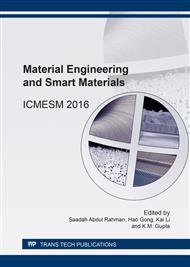p.3
p.8
p.14
p.23
p.28
p.33
p.37
p.45
Microstructure Evolution and Macro Segregation of Directionally Solidified Hypoeutectic and Hypereutectic Lead-Tin Alloys
Abstract:
Unidirectional solidification is preferred to multidirectional solidification for growing crystals in a particular direction. An experimental set-up consisting of Bridgman type of upward directional solidification was employed for the present investigation. The main aim of the present investigation was to assess the effect of unidirectional upward solidification on the segregation of off-eutectic Pb-Sn alloys at different translational speeds of the experimental set-up. Solidification experiments were conducted on hypoeutectic and hypereutectic Lead-Tin alloys. Different combinations of growth rate V and composition Co. were used to investigate their effect on longitudinal macro segregation. Macro segregation along the length of the samples was observed in hypoeutectic Pb-Sn alloys whereas no such macro segregation was observed in hypereutectic alloys. The intensity of longitudinal macro segregation was found to increase with the increase in initial tin content of the alloy, increase in distance from the chill end and decrease in the solidification rate.
Info:
Periodical:
Pages:
3-7
Citation:
Online since:
March 2017
Authors:
Keywords:
Price:
Сopyright:
© 2017 Trans Tech Publications Ltd. All Rights Reserved
Share:
Citation:


